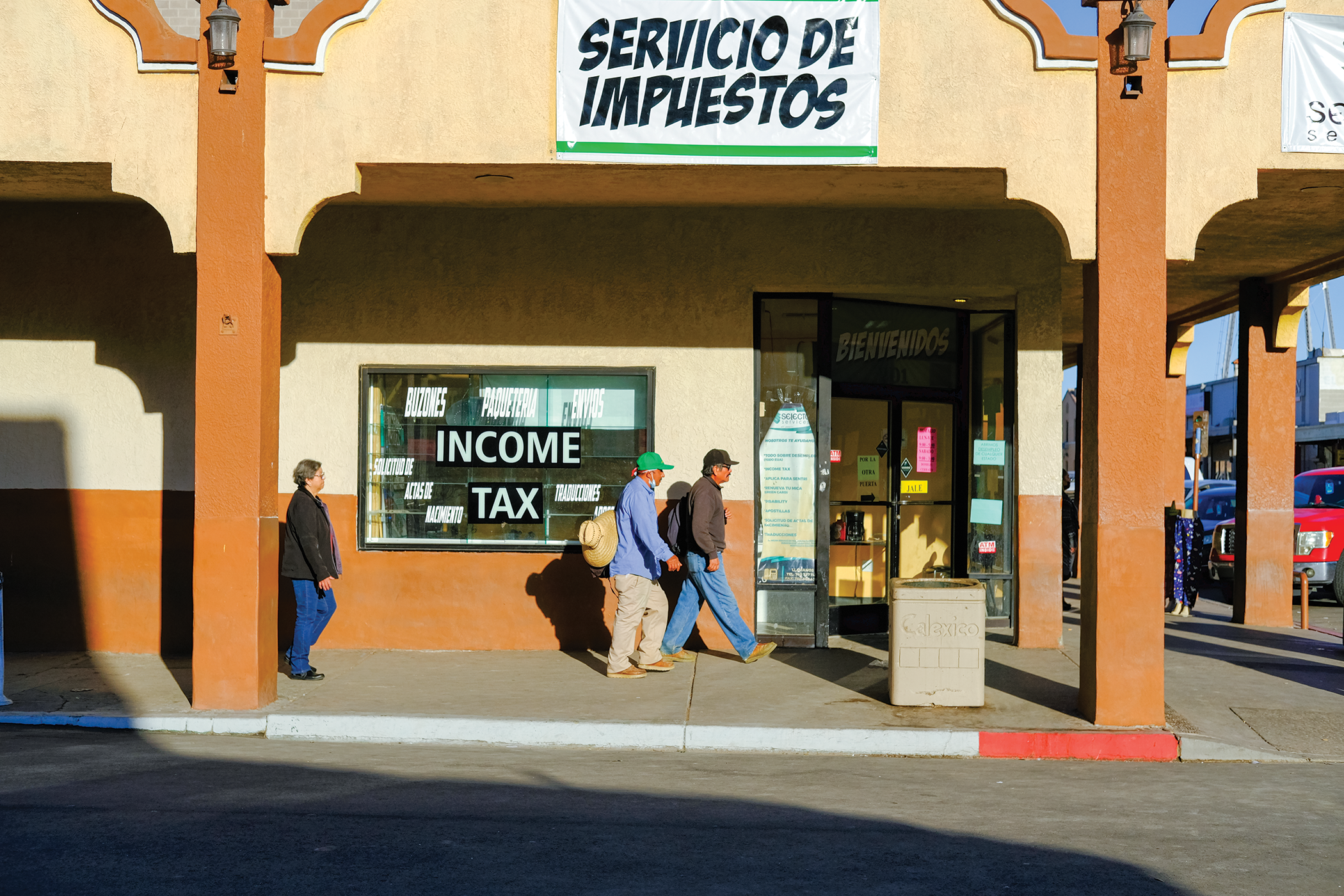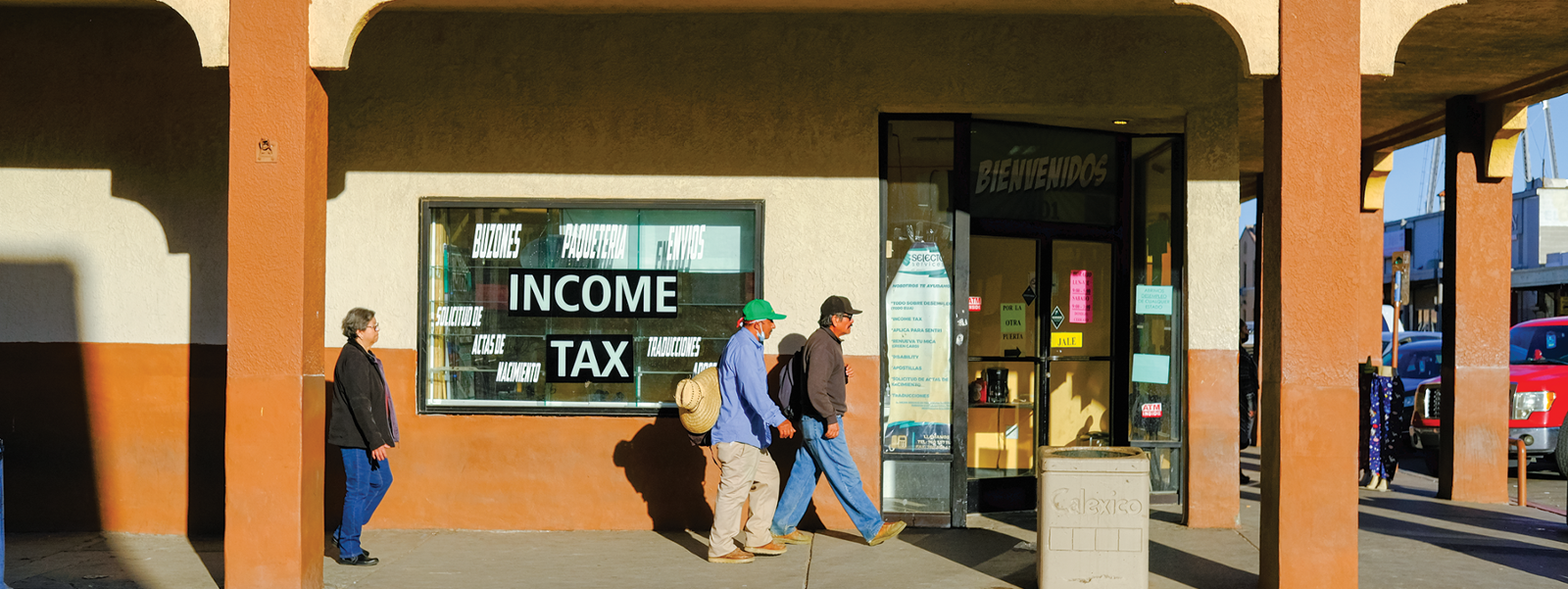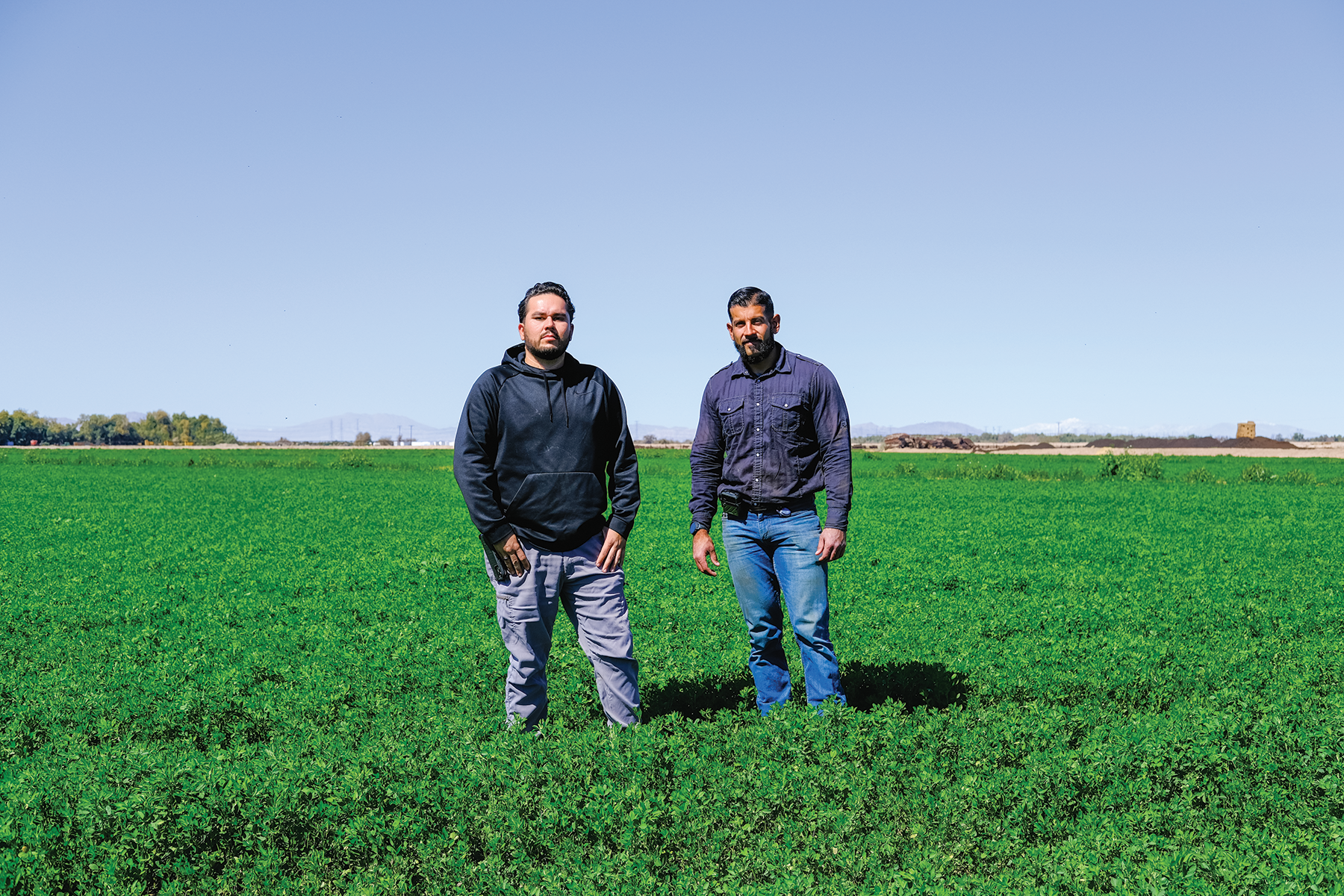As river runs dry, desert region is at a crossroads

Photo/Caleb Hampton
After a day in the fields, farmworkers walk through Calexico on their way home to Mexicali last month. Each year, an estimated 15,000 people cross the border to work on farms in the Imperial Valley.


Irrigators Alonso Cervantes, left, and Roberto Mariscal stand in an alfalfa field west of Calexico where they work. The agriculture sector employs one-sixth of all workers in the Imperial Valley.
By Caleb Hampton
As early as midnight, scores of Mexicali residents with U.S. citizenship or legal status line up at the port of entry. They cross into Calexico, walking past darkened storefronts, and gather near a 24-hour donut shop. Before dawn, they board buses for fields across the Imperial Valley.
Every year, some 15,000 people legally cross the border to work on farms in the region. In the winter, they join local residents in harvesting as much as 90% of the nation’s vegetables.
“If they’re working the cilantro or parsley, once the season is finished, they start with the carrots or they go to the broccoli or the lettuce,” said Adelaida Ibarra, a former farmworker and lead advocate for Sure Helpline, a local nonprofit.
For a hundred years, ever since engineers diverted water from the Colorado River, farming has shaped and sustained life in the valley. Imperial County’s $2.9 billion agriculture sector, wholly dependent on the Colorado River, accounts for a quarter of its economy, employing one-sixth of its workforce. Scientists warn the river could run dry within two years. As it dwindles, the region stands at a crossroads.
“If agriculture goes away, so goes the community,” said Tina Shields, water manager for the Imperial Irrigation District.
The Imperial Valley is home to 180,000 people. The largely Latino county has the state’s lowest median income and its highest jobless rate. Entitled to more than a third of all the water in the Colorado River’s Lower Basin, the region is both rich in water and uniquely reliant on it.
“The main assets we have are water, ground and sunshine,” said Larry Cox, whose family has farmed in the Imperial Valley since 1952. For decades, locals have made their living from the river and planned their futures around it.
Early last month, Roberto Mariscal repaired equipment on a hay farm outside Calexico. Mariscal’s father worked for years as an IID irrigation supervisor, moving water from the All-American Canal into farm ditches. Mariscal, who works for farmer Tom Brundy, hopes to do the same. “This job is an opportunity for me to learn water movement and water pressure—and ag in general—to get the experience I need to be able to join the district,” he said.
In the Imperial Valley, a large part of irrigators’ work is helping farmers manage water-saving irrigation systems so that farms can persevere with diminished water supplies. Since 2003, Imperial Valley farms have transferred up to 18% of their water each year to cities in Southern California. Now, under California’s plan to address the Colorado River crisis, the farms must forfeit an additional 9% of their water. To save the river, the federal government may intervene and enforce steeper cuts.
In recent years, the Imperial Valley has resisted fallowing farmland in order to prevent layoffs. But growers warn further water cuts would push them to the brink. “Any more water transfers out of this valley will mean crop production losses,” Imperial County farmer Ronnie Leimgruber said.
A blow to agriculture would touch local businesses far beyond farms. There are packinghouses and hay compressors, fertilizer and pesticide suppliers, and a service sector that caters to their employees. H-2A workers fill hotel guest ledgers, creating jobs for staff who tidy their rooms when the workers leave each morning for the fields. According to a 2019 study, ripple effects from Imperial County’s agriculture sector generated $1.4 billion—nearly half as much as the sector’s direct output—and employed 7,000 people.
“It would be very easy for me and all of the other farmers to take money to fallow our land,” said Imperial County farmer Mark Osterkamp, referring to programs in which farmers are paid not to grow crops. “That’s all well and good, except that it destroys the local economy. I’ve lived here my whole life. I don’t want to see it all dried up and ruined for some dollars.”
Despite having water rights that are senior to those of major Western cities, the Imperial Valley has faced mounting pressure to share its water with the cities as their populations soared in recent decades. The farmers know cities need water, but bearing that burden can be hard to take. “All they’re doing is transferring wealth out of Imperial Valley to Phoenix and Las Vegas,” Leimgruber said.
The valley is already hurting. In addition to its economic straits, drought has brought environmental challenges. As reduced water use starves the Salton Sea of the agricultural runoff that has long fed the basin, dust from the exposed lakebed blows across the region, where one in five children have been diagnosed with asthma.
“In other places, they have a lot more money and resources,” said Ibarra, the Sure Helpline advocate. “What’s going to happen if we have even less?”
Last month, California Gov. Gavin Newsom visited the Imperial Valley to highlight the construction of geothermal plants, which aim to tap the valley’s lithium deposits—among the world’s largest—and power the country’s shift to clean energy. There is optimism the industry will bring wealth and jobs. However, large-scale lithium extraction is new, difficult and expensive, and some experts predict it will be years before its potential is realized.
The Inflation Reduction Act includes $4 billion to address the Colorado River crisis. If farmland is fallowed, some of that money might be used to pay farmers and prop up local economies. But whatever investments are made, locals worry a shift away from farming will leave some behind. Just 14% of Imperial County residents aged 25 and older have college degrees. For many people, regardless of language or education, farms have provided a steady livelihood.
“There are no other jobs,” Oliva Gonzalez said in Spanish. For 20 years, Gonzalez woke up at 3 a.m. to work in the fields, harvesting lettuce, broccoli and cauliflower to support her family. “I did it for my children,” she said. “Now, they are professionals.” Both of her daughters graduated from San Diego State University. One is a licensed psychologist. The other is a paramedic.
Esther Bejarano, programs manager for Comité Cívico del Valle, recalled attending an El Centro elementary school surrounded by farmland. “I would be out there playing, and I would see my parents harvesting lettuce in the field,” she said. “I remember my father getting home from work, and I had to take off his boots and clean the mud from his toes. When you go through those things, it makes you proud of what they did and gives you a sense of wanting to do something for your community.”
That pride in the Imperial Valley’s heritage, and desire to see the region prosper, runs deep in a community that has worked the land for generations. “I have employees whose fathers and grandfathers worked for my family,” said Leimgruber, whose grandfather immigrated to the valley from Switzerland in 1918 and helped construct the All-American Canal. “I want my employees and their kids to be successful.”
Despite its challenges and its uncertain future, the valley is irreplaceable for those who have spent their lives there.
“I grew up here,” said Ibarra, who returned to the Imperial Valley after living in Los Angeles, and enjoys its environment and pace of life. Now that she is expecting her second child, she is more certain than ever she wants to stay. “I prefer it here for my kids,” she said.
(Caleb Hampton is an assistant editor for Ag Alert. He may be contacted at champton@cfbf.com.)
Read the series:
Part 1
Colorado River crisis tests a proud region
Facing cuts, farmers step up on water conservation
Part 2
Desert farmers defend maligned alfalfa production
Part 3




